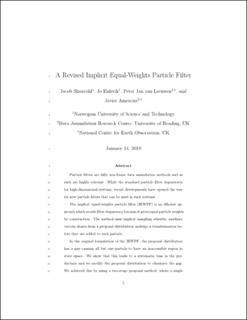| dc.contributor.author | Skauvold, Jacob | |
| dc.contributor.author | Eidsvik, Jo | |
| dc.contributor.author | van Leeuwen, Peter Jan | |
| dc.contributor.author | Amezcua, Javier | |
| dc.date.accessioned | 2020-05-18T08:18:59Z | |
| dc.date.available | 2020-05-18T08:18:59Z | |
| dc.date.created | 2019-07-08T19:36:10Z | |
| dc.date.issued | 2019 | |
| dc.identifier.citation | Quarterly Journal of the Royal Meteorological Society. 2019, 145 (721), 1490-1502. | en_US |
| dc.identifier.issn | 0035-9009 | |
| dc.identifier.uri | https://hdl.handle.net/11250/2654725 | |
| dc.description.abstract | Particle filters are fully nonlinear data assimilation methods and as such are highly relevant. While the standard particle filter degenerates for high‐dimensional systems, recent developments have opened the way for new particle filters that can be used in such systems.
The implicit equal‐weights particle filter (IEWPF) is an efficient approach that avoids filter degeneracy because it gives equal particle weights by construction. The method uses implicit sampling, whereby auxiliary vectors drawn from a proposal distribution undergo a transformation before they are added to each particle.
In the original formulation of the IEWPF, the proposal distribution has a gap, causing all but one particle to have an inaccessible region in state space. We show that this leads to a systematic bias in the predictions and we modify the proposal distribution to eliminate the gap. We achieved this by using a two‐stage proposal method, where a single variance parameter is tuned to obtain adequate statistical coverage properties of the predictive distribution. We discuss the properties of the implicit mapping from an auxiliary random vector to the state vector, keeping in mind the aim of avoiding particle resampling. The revised filter is tested on linear and weakly nonlinear dynamical models in low‐dimensional and moderately high‐dimensional settings, demonstrating the success of the new methodology in removing the bias. | en_US |
| dc.language.iso | eng | en_US |
| dc.publisher | Wiley | en_US |
| dc.title | A revised implicit equal-weights particle filter | en_US |
| dc.type | Peer reviewed | en_US |
| dc.type | Journal article | en_US |
| dc.description.version | acceptedVersion | en_US |
| dc.source.pagenumber | 1490-1502 | en_US |
| dc.source.volume | 145 | en_US |
| dc.source.journal | Quarterly Journal of the Royal Meteorological Society | en_US |
| dc.source.issue | 721 | en_US |
| dc.identifier.doi | 10.1002/qj.3506 | |
| dc.identifier.cristin | 1710710 | |
| dc.description.localcode | This is the peer reviewed version of an article, which has been published in final form at [https://doi.org/10.1002/qj.3506]. This article may be used for non-commercial purposes in accordance with Wiley Terms and Conditions for Self-Archiving. " | en_US |
| cristin.ispublished | true | |
| cristin.fulltext | preprint | |
| cristin.fulltext | postprint | |
| cristin.qualitycode | 2 | |
